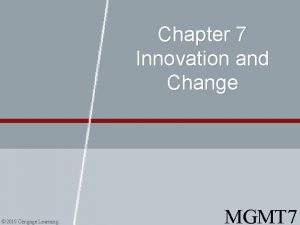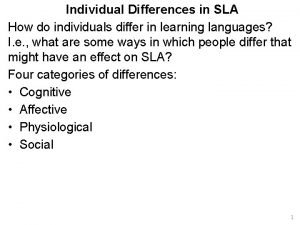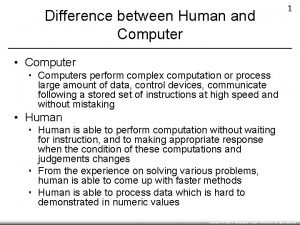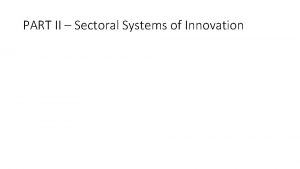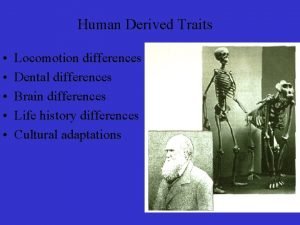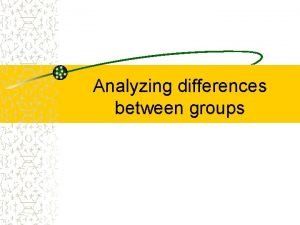Innovation differs sectoral approach Differences Innovation greatly differs






































































- Slides: 70

Innovation differs –sectoral approach

Differences… Innovation greatly differs across sectors in terms of: • characteristics, • sources, • actors involved, • the boundaries of the process, • and the organization of innovative activities.

Comparison among…. differences • A comparison of actors, sources, institutions, and policies for innovation in different sectors (e. g. in pharmaceuticals and biotechnology, chemicals, software, computers, semiconductors, telecommunications, or machine tools) shows striking differences. • The industrial economics approach pays a lot of attention to differences across sectors in: ü R&D intensity, ümarket structure, üthe range of viable R&D strategies and R&D alliances, üthe intensity of the patent race, üthe effectiveness of patent protection, üthe role of competition policy ü and the extent of R&D support. • But, while these are very important factors, they are not the only ones nor are they the most relevant for a full understanding of the differences in innovation across sectors.

Relevant issues… • Tradition of sectoral studies has clearly shown both that sectors differ in terms of: üthe knowledge base, üthe actors involved in innovation, üthe links and relationships among actors, üand the relevant institutions • These dimensions clearly matter for understanding and explaining innovation and its differences across sectors.

How discussing sectoral differences… We will briefly discuss: • the previous literature on differences across sectors in innovation (PART I) • then propose the concept of sectoral systems of innovation (PART II). • the basic building blocks of sectoral systems ü knowledge, ütechnological domains, üand sectoral boundaries üactors, relationships and networks üinstitutions • Then, the dynamics and transformation of sectoral systems is examined. • Finally, some policy implications and the challenges ahead are discussed.

PART I – What Literature tells us

Exploring difference…(1/2) 1) high R&D-intensive (such as electronics or drugs) and low R&Dintensive (such as textiles or shoes). 2) Another distinction, coming from the Schumpeterian legacy, focuses on differences in: ümarket structure and üIndustrial dynamics…. Schumpeter Mark I sectors (‘‘creative destruction’’) Schumpeter Mark II sectors (‘‘creative accumulation’’) 3) Technological regimes (TR)

Focusing on «Technological Regimes» • T. R. : notion introduced by Nelson and Winter (1982), referring to the learning and knowledge environment in which firms operate. • A specific Technological Regime: üdefines the nature of the problem firms have to solve in their innovative activities, üaffects the model form of technological learning, üshapes the incentives and constraints to particular behavior and organization; üand influences the basic processes of variety generation and selection

Components of «TR» Technological regime is composed by: a) Technological opportunity b) appropriability conditions, c) degrees of cumulativeness of technological knowledge, and d) characteristics of the relevant knowledge base.

a) Technological opportunities reflect the likelihood of innovating for any given amount of money invested in search. High opportunities provide powerful incentives to the undertaking of innovative activities and denote an economic environment that is not functionally constrained by scarcity. In this case, potential innovators may come up with frequent and important technological innovations.

b) Appropriability • Appropriability of innovations summarizes the possibilities of protecting innovations from imitation and of reaping profits from innovative activities. • High appropriability means the existence of ways of successfully protecting innovation from imitation. • A key diference among sectors refers to the sources of innovation and the appropriability mechanisms. Here, major di. Verences across sectors have been identi. Wed in terms of • appropriability means—patents, secrecy, lead-times, learning curves, and complementary assets. Many surveys have found major diferences across sectors in the use of patents.

c) Cumulativeness of techn. knowledge • Cumulativeness conditions capture the properties that today’s innovations and innovative activities form the starting point for tomorrow innovations. • Cumulativeness may be due to: üknowledge/cognitive factors*, üorganizational factors, or ümarket factors of the ‘‘success breeds success” type

d) knowledge base • Technological knowledge involves various degrees of specifcity, tacitness, complementarity, and independence and may greatly differ across sectors and technologies (Winter 1987).

Linking TR to Shumpeter «marks» ühigh technological opportunities, ülow appropriability, and ülow cumulativeness (at the firm level) conditions • tend to lead to a Schumpeter Mark I pattern. • By contrast, high appropriability and high cumulativeness (at the firm level) conditions lead to a Schumpeter Mark II pattern • But…technological regimes and Schumpeterian patterns of innovation change over time for sectors (Klepper 1996).

Sectors and «internal» TR changes over time • Early in the history of an industry—when knowledge is changing very rapidly, uncertainty is very high, and barriers to entry very low—new firms are the major innovators and are the key elements in industrial dynamics. • When the industry develops and eventually matures and technological change follows well-defined trajectories, economies of scale, learning curves, barriers to entry, and financial resources become important in the competitive process. • these analyses point to the direction of placing a lot of attention to differences across sectors in some key factors related to knowledge and learning regimes (also across time).

Exploring difference…(continues… 2/2) 4) Other distinctions refer to sectors that are: ünet suppliers of technology and üsectors that are users of technology. On the bases of the R&D done by 400 American firms and of intersectoral flows in the American economy, Scherer (1982) identifies: • sectors that are net sources of R&D for other sectors (such as computers and instruments), • and sectors that are net users of technology (such as textiles and metallurgy).

Providing or using innovation? …. • A) ‘‘core sectors’’ (such as electronics, machinery, instruments, and chemicals) which generate most of innovations in the economy and are net sources of technology; • B) secondary “innovating” sectors (such as auto and metallurgy) which play a secondary role; • C) “user sectors” such as services which mainly absorb technology.

The Pavit Taxonomy (1984) of sectoral innovation patterns Pavitt (1984) proposes four types of sectoral pattern for innovative activities. I. In supplier-dominated (e. g. textile, services) sectors, new technologies are embodied in new components and equipment, and the diffusion of new technologies and learning takes place through learning-by-doing and by-using. II. In scale-intensive sectors (e. g. autos, steel), process innovation is relevant and the sources of innovation are both internal (R&D and learning-by-doing) and external (equipment producers), while appropriability is obtained through secrecy and patents. III. In specialized suppliers (e. g. equipment producers), innovation is focused on performance improvement, reliability, and customization, with the sources of innovation being both internal (tacit knowledge and experience of skilled technicians) and external (user–producer interaction); appropriability comes mainly from the localized and interactive nature of knowledge. IV. Finally, science-based sectors (e. g. pharmaceuticals, electronics) are characterized by a high rate of product and process innovations, by internal R&D, and by scientifc research done at universities and public research laboratories; science is a source of innovation, and appropriability means are of various types, ranging from patents, to lead-times and learning curves,

PART II – Sectoral Systems of Innovation

What is a sector? • A sector is a set of activities that are unified by some linked product groups for a given or emerging demand which share some common knowledge. • Firms in a sector have some commonalities and at the same time are heterogeneous. • A multidimensional, integrated, and dynamic view of innovation in sectors is proposed, related to the framework of sectoral systems of innovation • together with a methodology for the analysis and comparison of sectors.

SIS and Evolutionary Theory • The theoretical and analytical approach of sectoral systems is grounded in the evolutionary theory. • Evolutionary theory places a key emphasis on dynamics, innovation processes, and economic transformation. • . . and on cognitive aspects such as beliefs, objectives, and expectations, which are in turn affected by previous learning and experience and by the environment in which agents act. • A central place in the evolutionary approach is occupied by the processes of ü variety creation (in technologies, products, firms, and organizations), ü replication (that generates inertia and continuity in the system), ü and selection (that reduces variety in the economic system and discourages the inefficient or ineffective utilization of resources). • Finally, for evolutionary theory, aggregate phenomena are emergent properties of far-fromequilibrium interactions and have a meta-stable nature. • Here, the environment and conditions in which agents operate may drastically differ. • Evolutionary theory stresses major differences in opportunities related to science and technologies.

• The same holds for the knowledge base underpinning innovative activities, as well as for the institutional context. Thus the learning, behavior, and capabilities of agents are constrained and ‘‘bounded’’ by the technology, knowledge base, and institutional context. • Heterogeneous firms facing similar technologies, searching around similar knowledge bases, undertaking similar production activities, and ‘‘embedded’’ in the same institutional setting, share some common behavioral and organizational traits and develop a similar range of learning patterns, behavior, and organizational forms. • One last remark regards the “aggregation issue” regarding products, agents or functions. • For example, sectoral systems may be examined broadly or narrowly (in terms of a small set of product groups).

Sectoral systems and other concepts… The notion of sectoral system of innovation and production complements other concepts within the innovation system literature (Edquist 1997) such as: National systems of innovation (NS) - delimited by national boundaries and focused on the role of non-frm organizations and institutions (Freeman 1987; Nelson 1993; Lundvall 1993), Regional/local innovation systems in which the boundary is the region; Technological systems, in which the focus is on technologies and not on sectors (Carlsson and Stankiewitz 1995; Hughes 1984; Callon 1992), Distributed innovation system (in which the focus is on specifc innovations) —Andersen et al. 2002).

NIS vs SIS • National Innovation Systems take innovation systems as delimited more or less clearly by national boundaries, • A Sectoral Innovation System approach would claim that sectoral systems may have local, national, and/or global dimensions. Often these three different dimensions coexist in a sector. • In addition, National Innovation Systems result from the different composition of sectors, some of which are so important that they drive the growth of the national economy.

• A broad definition allows us to capture all the interdependencies and linkages in the transformation of sectors, while a narrow definition identifies more clearly specific relationships. • We will concentrate on each block of a sectoral system of innovation and production: • A) Knowledge, technological domain, and boundaries • B) Agents, interaction and networks • . C) Institutions

Short introduction on key-elements in «Sectors» (1/2) • A) Knowledge and technological domain. Any sector may be characterized by a specific knowledge base, technologies and inputs. In a dynamic way, the focus on knowledge and the technological domain places at the centre of the analysis the issue of sectoral boundaries, which usually are not fxed, but change over time. • B) Actors and networks. A sector is composed of heterogeneous agents that are organizations or individuas (e. g. consumers, entrepreneurs, scientistf). Organizations may be firms (e. g. users, producers, and input suppliers) or non-firms (e. g. universities, Wnancial institutions, government agencies, trade-unions, or technical associations), and include subunits of larger organizations (e. g. R&D or production departments) and groups of organizations (e. g. industry associations). Agents are characterized by specific learning processes, competencies, beliefs, objectives, organizational structures, and behaviors, which interact through processes of communication, exchange, cooperation, competition, and command. • Thus, in a sectoral system framework, innovation is considered to be a process that involves systematic interactions among a wide variety of actors for the generation and exchange of knowledge relevant to innovation and its commercialization. • Interactions include market and non-market relations that are broader than the market for technological licensing and knowledge, inter. Wrm alliances, and formal networks of frms, and often their outcome is not adequately captured by our existing systems of measuring economic output.

A short introduction on key-elements in «Sectors» (2/2) • C) Institutions. Agents’ cognition, actions, and interactions are shaped by institutions, which include norms, routines, common habits, established practices, rules, laws, standards, and so on. • Institutions may range from ones that bind or impose enforcements on agents to ones that are created by the interaction among agents (such as contracts); from more binding to less binding; from formal to informal (such as patent laws or specific regulations vs. traditions and conventions). • A lot of institutions are national (such as the patent system), while others are specific to sectors (such as sectoral labor markets or sector specific financial institutions).

A) Knowledge, technological domain and sectoral boundaries Sectors and technologies differ greatly in terms of the knowledge base and learning processes related to innovation. Knowledge differs across sectors in terms of domains. 1. one knowledge domain refers to the specifc scientifc and technological fields at the base of innovative activities in a sector; . 2. while another k. d. comprises applications, users, and the demand for sectoral products.

Knowledge Based Economy and domains… Discontinuity has taken place in the processes of knowledge accumulation and distribution with the emergence of the knowledgebased economy It has: • redesigned existing sectoral boundaries, • affected relationships among actors, • reshaped the innovation process, and • modifieed the links among sectors.

Knowing knowledge… • Accessibility, • opportunity, • cumulativeness are key dimensions of knowledge related to the notion of technological and learning regimes

Focusing on accessibility of knowledge • Knowledge may have different degrees of accessibility ü gaining knowledge external to firms, ü internal or external to the sector. • Greater accessibility internal to the sector implies lower appropriability: competitors may gain knowledge! • Accessibility of knowledge that is external to the sector may be related to the levels and sources of scientifc and technological opportunities • It may be developed internally or externally (e. g. universities).

Where opportunities come from… The sources of technological opportunities differ markedly among sectors. 1. in some sectors opportunity conditions are related to major scientific breakthroughs in universities; 2. in others, opportunities to innovate may often come from advancements in R&D, equipment, and instrumentation; 3. while in still other sectors, external sources of knowledge (in terms of suppliers or users) may play a crucial role.

Knowledge and «transformability» • Not all external knowledge may be easily used and transformed into new artifacts. • If external knowledge is easily accessible, transformable into new artifacts and exposed to a lot of actors (such as customers or suppliers), then innovative entry may take place…

Knowledge and its «cumulativeness» (1/2) Second, knowledge may be more or less cumulative, i. e. the degree by which the generation of new knowledge builds upon current knowledge. One can identify three different sources of cumulativeness. • (1) Cognitive. The learning processes and past knowledge constrain current research, but also generate new questions and new knowledge. • (2) The firm and its organizational capabilities. Organizational capabilities are firm-specific and generate knowledge which is highly path-dependent. They implicitly define what a firm learns and what it can hope to achieve in the future. • (3) Feedbacks from the market, such as in the ‘‘success-breeds-success’’ process. Innovative success yields profits that can be reinvested in R&D, thereby increasing the probability to innovate again.

Knowledge and its «cumulativeness» (2/2) • High cumulativeness implies an implicit mechanism leading to high appropriability of innovations. • In the case of knowledge spillovers within an industry, it is also possible to observe cumulativeness at the sectoral level. • Finally, cumulativeness at the technological and firm levels creates “first mover advantages” and generates high concentration.

The «demand-side» of sectoral dynamic (1/2) • The boundaries of sectoral systems are affected by the knowledge base and technologies. • However, the type and dynamics of demand represent a major factor in the processes of transformation of sectoral systems (see later!). Market links and complementarities are, • of the static type (as are input–output links). • dynamic complementarities, (interdependencies and feedbacks, both at the demand at the production levels).

The «demand-side» of sectoral dynamic (2/2) In a sectoral system, demand is not seen as an aggregate set of similar buyers or atomistic undifferentiated customers, but as composed of heterogeneous agents who interact in various ways with producers. Demand then becomes composed by individual consumers, firms, and public agencies, which are in turn characterized by knowledge, learning processes, and competences (and which are affected by social factors and institutions). The emergence and transformation of demand become then a very important part in the dynamics and evolution of sectoral systems. In addition, demand has often proven to be a major factor in the redefinition of the boundaries of a sectoral system,

Complementarity among artifacts/processese • Dynamic complementarities among artifacts and activities are major sources of transformation and growth of sectoral systems, and may set in motion virtuous cycles of innovation and change. • This could be related to the concept of “filiera” (supply chain)

Changing boundaries (with differences…) • The boundaries of sectoral systems may change more or less rapidly over time, as a consequence of: üdynamic processes related to the transformation of knowledge, üthe evolution and convergence in demand, üchanges in competition and learning by firms. • Great differences among sectors in the dimensions discussed above exist. Case study: pharmaceuticals vs machine tools.

Pharmaceutical… • In the Pharma industry, the knowledge base and the learning processes have greatly affected innovation and the organization of innovative activities. • Even before the ’ 80, explosion of R&D and, although few blockbusters were discovered in each period, nevertheless, each period enjoyed high growth. The advent of molecular biology since the 1980 s led to a new learning regime based on molecular genetics and r. DNA technology…

…Machine tools • In machine tools, innovation has been mainly incremental and now is increasingly systemic. • Knowledge about applications is (was) very important, and therefore user– producer relationships as well as partnerships with customers are common. • The knowledge base has been embodied in skilled personnel on the shop floor level (with applied technical qualification) and in design engineers (not necessarily with a university degree but with long-term employment in the company). • Internal training (particularly apprenticeships) is quite relevant. • In small firms, R&D is not done extensively and R&D cooperation is not common. • Recently, the knowledge base has shifted from purely mechanical to mechanic, microelectronic and information intensive, with an increasing codification and an increasing use of formal R&D. Products have increasingly being modularized and standardized (more formal sources – international markets). • A key role is also played by information flows about components coming from producers of different technologies, such as lasers, materials, measurement, and control devices.

B) Actors and Networks • Sectoral systems are composed of heterogeneous actors. • In general, a rich, multidisciplinary, and multisource knowledge base and rapid technological change implies a great heterogeneity of actors in most sectors. • Within sectoral systems, heterogeneous agents are connected in various ways through market and non-market relationships. • FIRM subjects • NON FIRM subjects

Firm heterogeneity • The extent of firm heterogeneity is the result of the opposing forces of variety creation, replication, and selection • Firm heterogeneity is also affected by the characteristics of the knowledge base, specific experience and learning processes, and the working of dynamic complementarities. • (Firm) actors also include users and suppliers who have different types of relationships with the innovating, producing, or selling firms. • Users and suppliers are characterized by specific attributes, knowledge, and competencies, with more or less close relationships with producers (Von. Hippel 1988, Lundvall 1993).

Individuals… Often the most appropriate units of analysis in specific sectoral systems are not necessarily firms but… 1. individuals (such as the scientist who opens up a new biotechnology firm), 2. firms’ subunits (such as the R&D or the production department), and 3. groups of firms (such as industry consortia).

Non firm agents Other types of agents in a sectoral system are non-firm organizations such as: • universities, • financial organizations, • government agencies, • local authorities, and so on In various ways, they support innovation, technological diffusion, and production by firms, but again their role greatly differs among sectoral systems.

Universities and V. C. • In several high technology sectors, universities play a key role in basic research and human capital formation • In some sectors (e. g. biotechnology and software) they are also a source of start-ups and even innovation. • Relationships between firms and non-firm organizations (such as universities and public research centers) have been a source of innovation and change in several sectoral systems: pharmaceuticals and biotechnology, information technology, and telecommunications have been relevant. • In sectoral systems such as software or biotechnology–pharmaceuticals, new actors such as venture capital companies have emerged over time.

Focusing on «relationships» and networking (1/2) • The key role played by networks in a sectoral system leads to a meaning of the term ‘‘sectoral structure’’ different from the one used in industrial economics. • In industrial economics, structure is related mainly to the concept of market structure and of vertical integration and diversification. • In a sectoral system perspective, on the contrary, structure refers to links among artifacts and to relationships among agents: • it is therefore far broader than the one based on exchange– competition–command.

Focusing on «relationships» and networking (2/2) Different types of relations, linked to different “analytical cuts”. First, traditional analyses of industrial organizations have examined agents as involved in processes of: üexchange, ücompetition, üand command (such as vertical integration). In more recent analyses, processes of formal cooperation or informal interaction among firms (or subjects) have emerged: ütacit or explicit collusion, ü hybrid governance forms, or üformal R&D cooperation).

Cooperation and interaction (towards networks) • Recent literature has analyzed firms with certain market power, suppliers or users facing opportunistic behavior or asset specificities in transaction, and firms with similar knowledge having appropriability and indivisibility problems in R&D. • Finally, the evolutionary approach and the innovation systems literature have also paid a lot of attention to the wide range of formal and informal cooperation and interaction among firms. • Thus, networks integrate complementarities in knowledge, capabilities, and specialization (e. g. firm-universities networks) trough webs of relationships among heterogeneous agents with different beliefs, goals, competencies, and behavior, and that these relationships affect agents’ actions. (They are rather stable over time).

Great differences among sectoral systems The types and structures of relationships and networks differ greatly from sectoral system to sectoral system, as a consequence of the features of the knowledge base, the relevant learning processes, the basic technologies, the characteristics of demand, the key links, and the dynamic complementarities. Cases • Chemicals • Computers • Semiconductors • Software

Chemicals • In chemicals, the structure of the sectoral system has been centered around large firms, which have been the major source of innovation over a long period of time. • Large R&D expenditures, economies of scale and scope, cumulativeness of technical advance, and commercialization capabilities have given these firms major innovative and commercial advantages. • With the diffusion of the synthetic model, firms scaled up their R&D departments and the role of universities increased. • The introduction of polymer chemistry (1920 s) affected the structure of the industry because knowledge about the characteristics of different market segments became important, so that firms had to develop extensive linkages with downstream markets. • The other major change related to the development of chemical engineering and the concept of unit of operation led to an increasing division of labor between chemical companies and technology suppliers, with the rise of the specialized engineering firms (SEFs), which developed vertical links with chemical companies. In this period, university research continued to be important for the development of innovations, and links between universities and industry increased. • In addition, advances in chemical disciplines and the separability of knowledge increased the transferability of chemical technologies. Thus, there has been a greater role of licensing also by large firms, which in turn increased knowledge diffusion.

Computers • The different stages of the evolution of the industry (related to different products) have been characterized by different actors and networks. • Having been a typical Schumpeter Mark II sector for most of its history (until very recently), mainframe computers have always been dominated by large firms, with high cumulativeness of technical advance. • In particular, during the 1960 s and 1970 s, mainframes were produced and integrated by vertically integrated firms, and IBM was the typical example. IBM was producing both components and systems and was active in the development, manufacturing, marketing, and distribution of large systems and of the key components. • When minicomputers were introduced, the computers sector experienced the entry and growth of firms specialized in components or in systems (with the early years characterized by a Schumpeter Mark I pattern). The same holds for the early years of microcomputers. • Later on, however, competition became characterized by groups of specialized firms related to different platforms. Each platform was characterized by divided technical leadership of several disintegrated firms. • Innovation became decentralized, and the control over the direction by a single firm became very difficult. Recently, in computer networks, modularity and connectedness increased the role of networks of firms with local development and local feedbacks (Bresnahan and Greenstein 1999; Bresnahan and Malerba, 1999).

Semiconductors • In semiconductors, the industry has been characterized by a quite different set of actors, ranging from merchant semiconductor manufacturers to vertically integrated producers. • The types of actors have been quite different from period to period and from country to country during the evolution of the industry. • New entrants and specialized producers were quite relevant in the United States, with entrants particularly high either early on in the history of the industry or during phases of technological discontinuities (and giving the industry a typical Schumpeter Mark I fashion in these periods of rapid and radical change). • Large, vertically integrated producers were more common in Japan and Europe (Malerba 1985; Langlois and Steinmueller 1999). T hus, in these countries a Schumpeter Mark II mode characterized the industry. • In semiconductors, other main actors have played a major role. The military was one of the major factors responsible for the growth of the American industry, compared to Europe and Japan, because it supported the entry of new firms and provided competent firms with a large and innovative demand. • During the 1970 s in Japan, MITI was a major factor in allowing the Japanese industry (composed of large producers) to close the gap with American producers in some product ranges (such as memory devices).

Software • In software, specialization of both global players and local producers is present. • In addition, the changing knowledge base has created an evolving division of labor among users, ‘‘platform’’ developers, and specialized software vendors (Bresnahan and Greenstein 1998). • The sectoral system of innovation in software, however, is incomplete without the addition of companies that utilize these platforms to deliver enterprise-critical applications. • Many of these applications continue to be produced in-house by organizations using the tools provided as part of the platform or available from the development tools markets (Steinmueller 2004).

C) Institutions • In all sectoral systems, institutions play a major role in affecting the rate of technological change, the organization of innovative activity, and performance. • Institutions may emerge either as a result of deliberated planned decision by firms or other organizations, or as the unpredicted consequence of agents’ interaction. • Some institutions are sectoral, i. e. specific to a sector, while others are national. • Again, major differences emerge across sectors, as in the case of pharmaceuticals, software, machine tools, and telecommunications, for example (see later).

National institutions have different effects on sectors. For example, üthe patent system, üproperty rights regulations, or üantitrust regulations have different effects as a consequence of the different features of the systems. he same The same institution may take different features in different countries. Some sectoral systems become predominant in a country because the existing institutions of that country provide an environment more suitable for certain types of sectors and not for others. For example, in France, sectors related to public demand have grown considerably In other cases, national institutions may constrain development or innovation in specific sectors

Pharmaceuticals and software In pharmaceuticals, national health systems and regulations have played a major role in affecting the direction of technical change, in some cases even blocking or retarding innovation. In addition, patents have played a major role in the appropriability of the returns from innovations. In software, standards and standard setting organizations are important, and IPR play a major role in strengthening appropriability. However, the emerging open source movement aims to create a new segment of the software industry which is characterized by new distribution methods and by cooperative production activities based on voluntary association. This has reduced the possibility of maintaining proprietary control over data structure, thus inducing entry and more competition (Steinmueller 2004).

Machine tools and telecommunications In machine tools, internal and regional labor markets and local institutions (e. g. local banks) have played a major role in influencing international advantages of specific areas. Trust-based, close relationships at the regional level have over a long time ensured a sufficient financing of the innovation and of the expansion plans of family businesses in Germany and Italy (Wengel and Shapira 2004). In telecommunications, the roles of regulation, liberalization/privatization, and standards have been of major importance in the organization and performance of the sector. liberalization and privatization have had major effects on the behavior and performance of incumbents and have transformed the structure of the industry. An example of the role of institutions is given by GSM in Europe.

Part III • Dynamic of transformation and policies

The dynamic of transformation Three key mechanisms: • generation of variety, • selection, and • replication Entrepreneurs provide variety. Decision makers, especially in the form of markets, provide for selection. Selected technologies, those enabling survival and prosperity are then copied and imitated throughout the economic system. However, key mechanisms deeply differ from sector to sector!

The variety creation • Sectoral systems differ extensively in the processes of variety creation and of heterogeneity among agents. The creation of new agents—both new firms and non-firm organizations - is particularly important for the dynamics. The role of new firms differs drastically from sector to sector (in terms of entry rates, composition, and origin), and thus has quite different effects on the features of sectoral systems and their degree of change. Sectoral differences in the level and type of entry seem to be related to: üdifferent knowledge base; ülevel, diffusion and distribution of competences; üthe presence of non-firm organizations (VC, Univ, ); üand the working of sectoral institutions

The selection process • Processes of selection play the key role of reducing heterogeneity among firms (driving out ineffcient or less progressive firms). • In addition to market selection, in several sectoral systems nonmarket selection processes are at work, as in the cases of the involvement of the military, the health system, and so on. • Selection affects the growth and decline of the various groups of agents and may greatly differ across sectoral systems (intensity and frequency). • Changes in sectoral systems are the result of coevolutionary processes of their various elements, involving knowledge, technology, actors, and institutions.

Dynamics… • These processes are often sector-specifc and often path-dependent. • Sectors with competing technologies such as nuclear energy (Cowan 1990), cars (and their power sources), metallurgy (ferrous casting) and multimedia (VCR) show interesting examples of path-dependent processes. • Here, local learning, interactions among agents, and networks may generate increasing returns and irreversibilities that may lock sectoral systems into inferior technologies. • In addition, the interaction between knowledge, technology firms, and institutions are also shaped by country-specific factors. • Firms have diverse reactions in order to try to increase to survive in their particular environment. These environments keep changing, not least due to innovations and choices made by all the constituent competitors: some of these environments are national, others increasingly international.

Cases (see chapter)

Designing Sectoral Policy • A certain ‘‘problem’’—for example, weak technological transfer between universities - is a ‘‘system failure. ’’ • Not until they know the character of the system failure can policy makers know whether to infuence or to change organizations or institutions or the interactions between them. • Identification of a problem should be supplemented with an analysis of its causes as part of the analytical basis for the design of an innovation policy. • Benchmarking is not enough.

Starting from analysis Sectoral analyses should focus on systemic features in relation to: üknowledge and boundaries, üheterogeneity of actors and networks, üinstitutions and transformation (co-evolutionary processes) • Given the major differences among sectoral systems, the impact of general or horizontal policies may drastically differ across sectors • For example: cooperation and networks or non-firm organizations and institutions could have different relevance in different sectors. Therefore, policies affecting networks or non-firm organizations, such as transfer agencies, have to take these differences into account.

Wide range of policies • A sectoral system approach emphasizes that, for fostering innovation and diffusion in a sector, technology and innovation policies may not be enough. • A wide range of other policies may be necessary. • Innovation and technology policy could be supplemented by other types of policies, such as: üscience policy, üIndustrial policy, üpolicies related to standards and IPR, üand competition policy. Importance of the interdependencies, links, and feedbacks among all of these policies, and their combined effects…

Traditional and advanced policies Traditional innovation policies have been formulated as providing public resources for R&D and changing the incentives for firms to innovate. Tax breaks for R&D, innovation subsidies, and patents are typical examples of these policies. A sectoral system perspective does not deny the signi. Wcance of this approach. It recognizes, however, that the effects may run rapidly into diminishing returns. Policy makers need to invest much more effort in understanding the idiosyncrasies of the specific sectors that they use to channel the infuence of policy.

Different geographical and sector dimensions Coexistence of different geographical dimensions of sectoral systems. Developments in the local, national, regional, and global levels influence the articulation of technological capabilities. Policies that focus on only one level are likely to miss constraints or opportunities that are influential in the innovative behavior of individual organizations. * Policy needs are closely related to the problems faced by the various actors operating in the sectoral contexts and to the sectoral specifcity of knowledge, boundaries, actors, and networks.

Policy makers as active part Policy makers (being within a variety of networks) are an active internal part of sectoral systems. In fact, the policy makers intervene actively in: ü knowledge creation, üIPR, ücorporate governance rules, ütechnology transfer, üfinancial institutions, üskill formation, and üpublic procurement. As a consequence, they have to develop advanced competences and create an institutional setting in order to be effective and consistent at the various different levels.
 Blueprint for sectoral cooperation on skills
Blueprint for sectoral cooperation on skills Sectoral training
Sectoral training Intra sectoral coordination
Intra sectoral coordination Leading greatly
Leading greatly Who will get affected by this issue
Who will get affected by this issue When dishes remain on a table when you yank
When dishes remain on a table when you yank Rejoiced greatly
Rejoiced greatly Greatly inspired
Greatly inspired God is an awesome god and greatly to be praised
God is an awesome god and greatly to be praised Radical innovation vs disruptive innovation
Radical innovation vs disruptive innovation Innovation for the sake of innovation
Innovation for the sake of innovation Compression approach to innovation
Compression approach to innovation Compression approach to innovation
Compression approach to innovation Difference between datagram and virtual circuit
Difference between datagram and virtual circuit Study approach meaning
Study approach meaning Shower approach marketing
Shower approach marketing Cognitive approach vs behavioral approach
Cognitive approach vs behavioral approach Traditional approach vs object oriented approach
Traditional approach vs object oriented approach Multiple conflict
Multiple conflict Tony wagner's seven survival skills
Tony wagner's seven survival skills Cognitive approach vs behavioral approach
Cognitive approach vs behavioral approach Verilog data type
Verilog data type Explain how physical beauty differs from inner beauty
Explain how physical beauty differs from inner beauty A compound differs from an element in that a compound
A compound differs from an element in that a compound Promotional channels
Promotional channels Venn diagram formal education and nonformal education
Venn diagram formal education and nonformal education Formal culture region differs from other regions in that it
Formal culture region differs from other regions in that it 4 principles of conscious marketing
4 principles of conscious marketing What does product and service design do
What does product and service design do The great gatsby chapter 3
The great gatsby chapter 3 Actual grace and sanctifying grace
Actual grace and sanctifying grace A compound differs from an element in that a compound
A compound differs from an element in that a compound An mbb differs from a cmo or a pass-through in that
An mbb differs from a cmo or a pass-through in that Operant vs classical conditioning
Operant vs classical conditioning Differences between nephrotic and nephritic syndrome
Differences between nephrotic and nephritic syndrome Manorialism pyramid
Manorialism pyramid Generational differences chart
Generational differences chart Chapter 9: ethics of documentation and authentication
Chapter 9: ethics of documentation and authentication Greek philosophers in physical education
Greek philosophers in physical education Individual differences in sla
Individual differences in sla Sequential program and an event-driven program?
Sequential program and an event-driven program? Difference between computer and human
Difference between computer and human Similarities and differences
Similarities and differences Actual and ideal self example
Actual and ideal self example Define research design
Define research design Diff between schottky and frenkel defects
Diff between schottky and frenkel defects Learner differences and learning needs
Learner differences and learning needs What are constructive waves
What are constructive waves Difference between jung and freud
Difference between jung and freud Buddhism and hinduism differences chart
Buddhism and hinduism differences chart Understanding human differences 5th edition
Understanding human differences 5th edition What type of art
What type of art Whmis vs hhps
Whmis vs hhps Shia
Shia Moral definition
Moral definition Deloitte asc 740 guide
Deloitte asc 740 guide Dr bino
Dr bino Difference between wid, wad and gad concepts
Difference between wid, wad and gad concepts Definition of micro teaching
Definition of micro teaching Entry posture diagram
Entry posture diagram Difference between series and parallel circuit
Difference between series and parallel circuit How did the anishinabe make decisions
How did the anishinabe make decisions Finite differences
Finite differences Task specialist role
Task specialist role Differences between phonetics and phonology
Differences between phonetics and phonology What is the difference between team and group
What is the difference between team and group Mitosis and meiosis differences
Mitosis and meiosis differences Venn diagram ant and grasshopper
Venn diagram ant and grasshopper Individual differences factors
Individual differences factors Differences between adjectives and adverbs
Differences between adjectives and adverbs Compare and contrast the monkey's paw
Compare and contrast the monkey's paw












